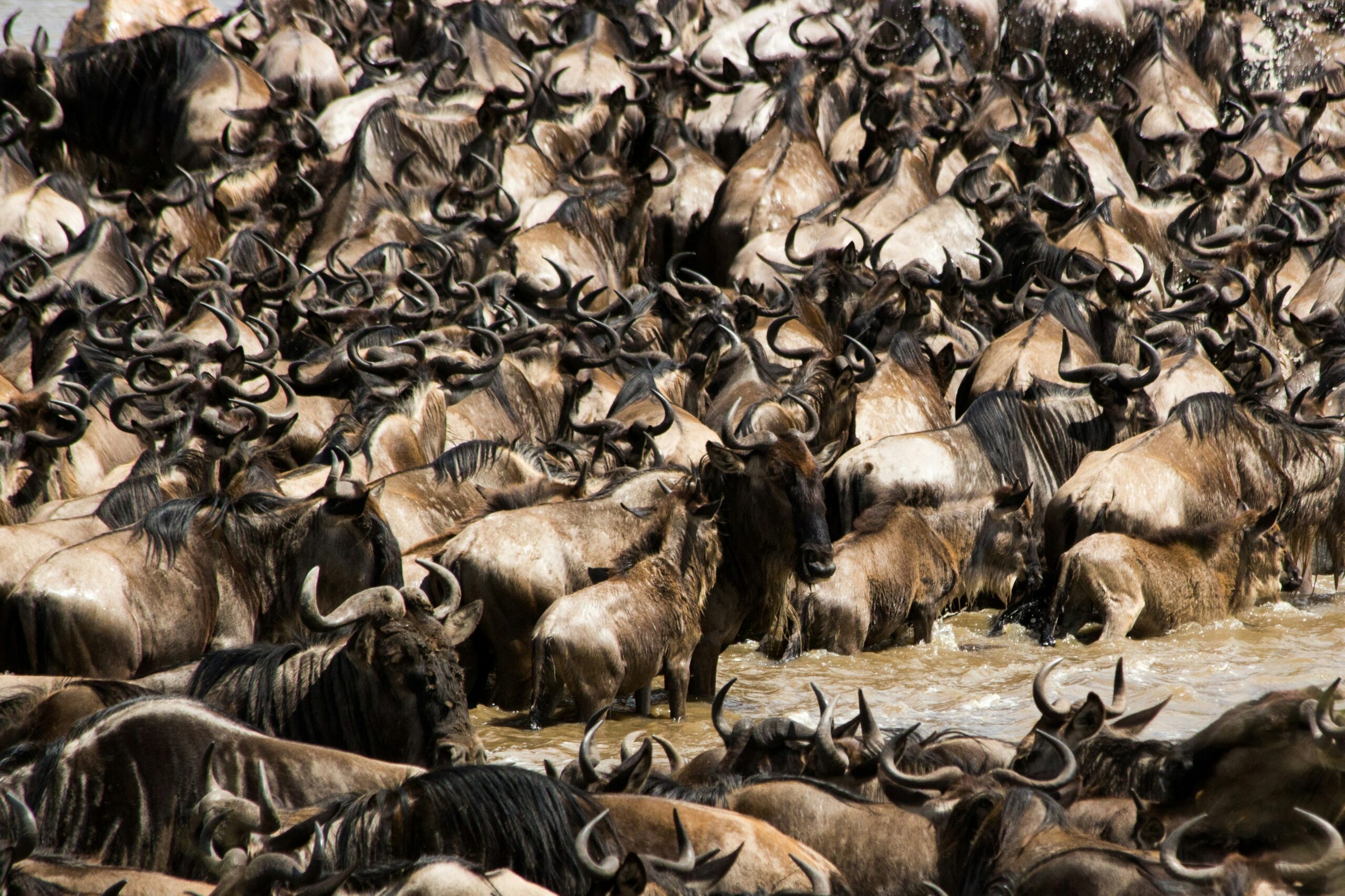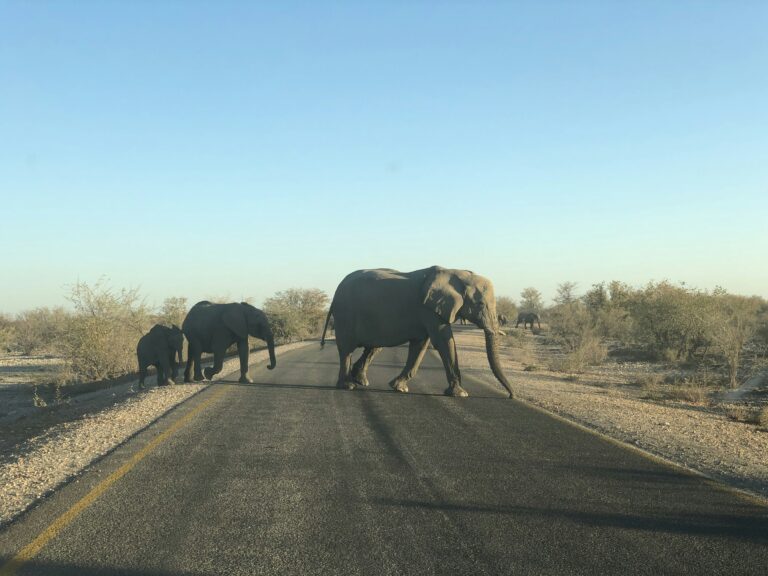Witnessing the Great Migration
Wildebeest Migration : Imagine a natural event so vast it’s visible from space. Over 1.5 million animals surge across East Africa in a relentless search for fresh grasslands, creating Earth’s largest overland wildlife spectacle. This ancient cycle—spanning Tanzania’s Serengeti and Kenya’s Masai Mara—supports entire ecosystems and has shaped the region for millennia.
The herds follow a 1,200-mile circular route, driven by primal instincts and seasonal rains. From the Ngorongoro Conservation Area to the Mara River’s treacherous crossings, their journey is a primal dance of survival. Predators like lions and crocodiles thrive here, relying on this life-sustaining movement.
What makes this phenomenon unforgettable? Sheer scale. At peak density, 1,000 animals crowd each square kilometer, forming living rivers that stretch beyond the horizon. It’s not just about numbers—it’s witnessing nature’s raw balance, where every grazing step nourishes the soil and fuels biodiversity.
This guide unlocks how to experience this marvel firsthand. You’ll learn why timing matters, where to witness dramatic river crossings, and how this epic trek reshapes landscapes—and perspectives.
Introduction to the Great Migration Experience
Every year, an ancient pulse drives over a million animals across Africa’s plains. You’ll feel the earth vibrate as herds move like living rivers, their hooves kicking up dust visible for miles. This isn’t just a journey—it’s nature’s most epic survival story.
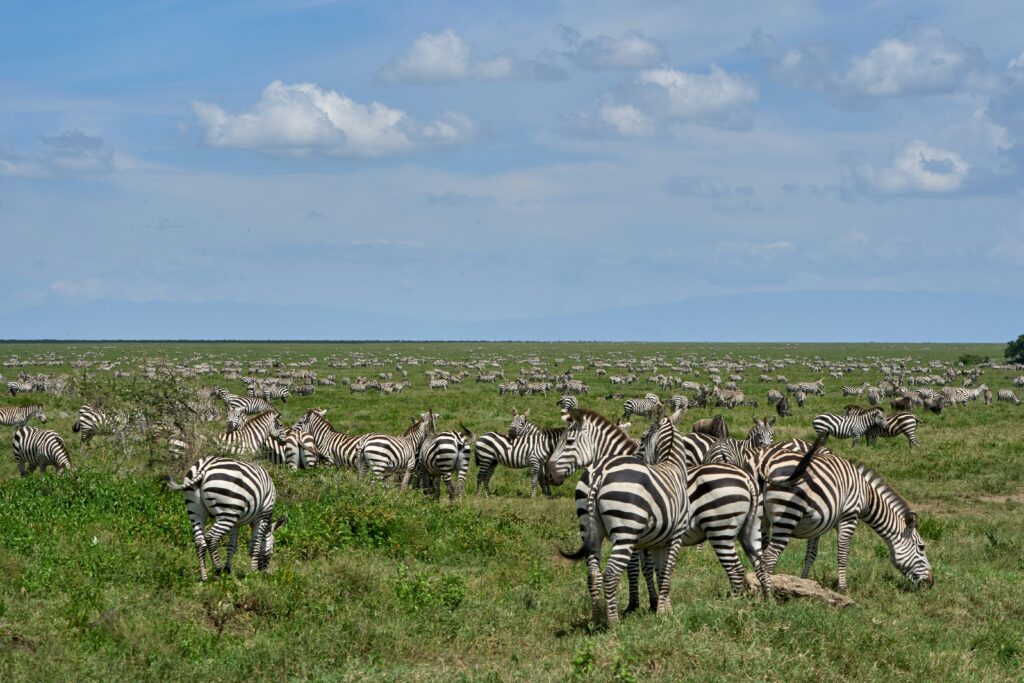
What Makes This Journey Unforgettable
You’ll hear the symphony first—grunts, gallops, and rumbling earth. Then comes the sight: endless columns of animals flowing across golden grasslands. In one moment, you might see newborn calves stumbling to keep up; in the next, crocodiles erupting from muddy rivers.
| Species | Numbers | Annual Distance | Key Role |
|---|---|---|---|
| Wildebeest | 1.2 million | 800-1,000 km | Grassland renewal |
| Zebra | 300,000 | Same route | Pathfinding |
| Gazelles | 200,000+ | Varies | Prey balance |
The Scale and Significance
These numbers reshape entire ecosystems. Grazing patterns fertilize soils, while predator activity keeps populations healthy. Your presence connects you to a cycle older than human civilization—a dance where every participant matters.
This spectacle isn’t just about thousands of creatures moving. It’s Earth’s way of showing how life persists against all odds. You leave understanding why biologists call this the greatest show nature ever staged.
Understanding the Great Migration: Key Facts and Figures
Picture a living engine powering Africa’s plains—massive herds surging across borders in a relentless quest for survival. This natural phenomenon isn’t just about movement—it’s a finely tuned system where every participant plays a critical role.
Nature’s Marathon Runners
Over 1.4 million hoofed travelers embark on an 800-kilometer circuit annually. Zebra lead the charge, using sharp vision to navigate, while bulkier companions follow.
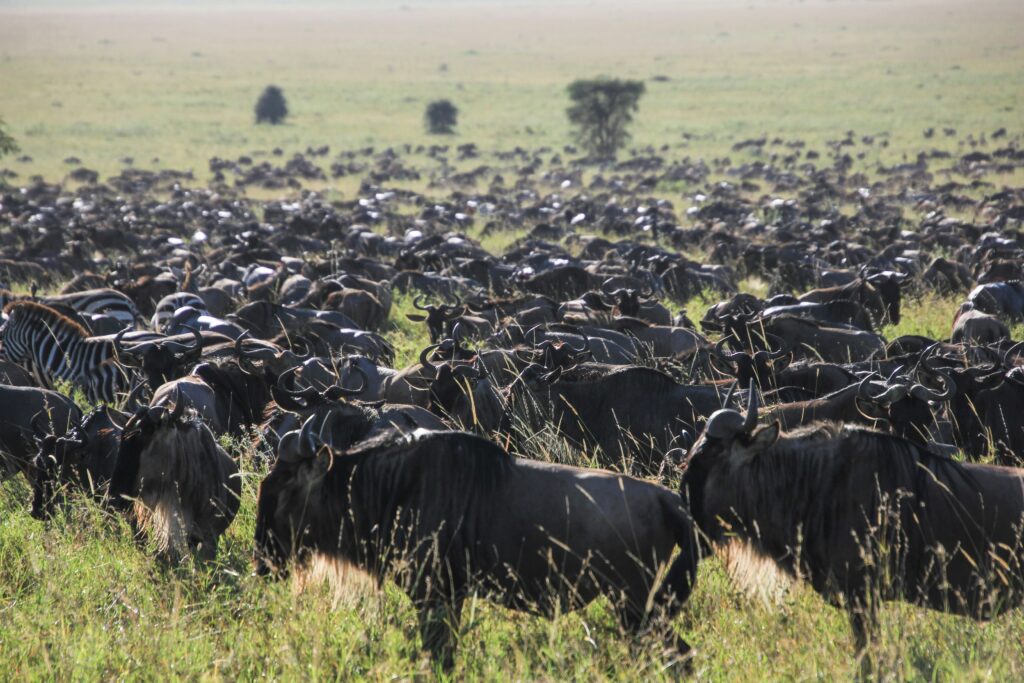
| Species | Grazing Style | Ecosystem Role |
|---|---|---|
| Zebra | Tall grass tops | Clear pathways |
| Wildebeest | Mid-length stems | Soil fertilization |
| Gazelles | Short leftovers | Prevent overgrowth |
Life, Death, and Renewal
Nearly 300,000 animals perish yearly—victims of predators, rivers, and exhaustion. These losses sustain scavengers and fertilize the land. Rain patterns trigger movements, creating a self-regulating cycle older than human history.
You’ll see how zebra teeth cut tall grasses, allowing shorter species access to nutrients. This layered grazing maintains grassland health across millions of acres—a perfect example of nature’s balance.
Seasonal Highlights and Month-by-Month Overview
Africa’s plains transform in a heartbeat when the rains arrive. This annual cycle fuels one of Earth’s most precisely timed natural events. You’ll see life explode across the landscape as herds follow ancient routes shaped by weather patterns and survival instincts.
Birth Season and Calving in the Southern Plains
February brings a surge of life to the southern Serengeti. Over 400,000 calves drop to the ground daily—newborns learning to walk within minutes. Predators circle relentlessly, creating heart-pounding scenes of survival.
These nutrient-rich plains become a nursery. Watch mothers nudge wobbly-legged young to keep pace with moving herds. The spectacle peaks by March’s end as rains nourish fresh grasses.
Migratory Movements Through Serengeti and Maasai Mara
April’s showers push herds northwest toward central Serengeti. By June, they mass at the Grumeti River—your first chance to witness river crossings. Come July, the frontrunners reach Kenya’s Maasai Mara.
| Month | Location | Key Event |
|---|---|---|
| Feb-Mar | Southern Serengeti | Calving season |
| Apr-May | Central Serengeti | Mating battles |
| Jun-Jul | Western Corridor | Grumeti crossings |
Peak River Crossing Periods
August’s timing determines the Mara River drama. You’ll hear splashing hooves and snapping crocodile jaws as herds brave treacherous currents. Some years see crossings extend into October.
By November, rains draw animals southward again. Smaller groups scatter across eastern plains, completing the year’s epic circuit. Nature’s clock resets—ready to awe you anew.
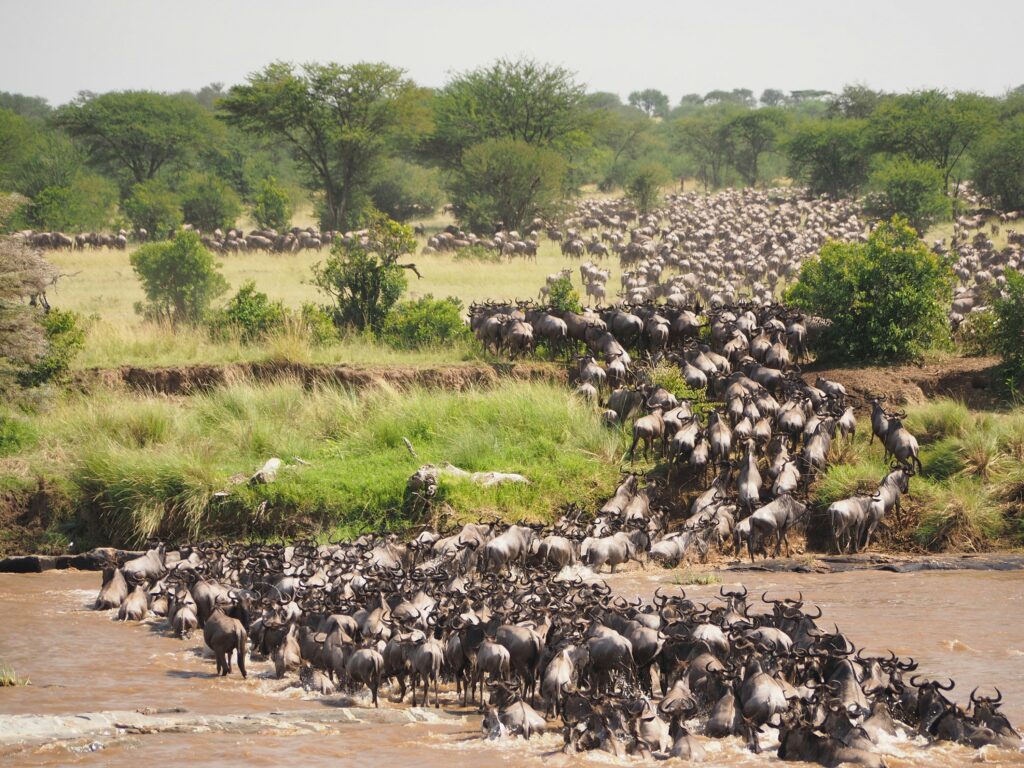
Planning Your Ultimate Wildebeest Migration Trip
The key to an unforgettable safari lies in when and where you stay. Aligning your travel dates with nature’s schedule transforms ordinary wildlife viewing into front-row seats for Earth’s greatest survival drama.
Best Times of Year to Visit
Your ideal time depends on which spectacles matter most. July through September delivers heart-pounding river crossings, while April to June surrounds you with endless grazing herds. For newborn calves taking their first steps, target January to March.
Savvy travelers often pick May—low-season rates meet prime wildlife action with minimal crowds. You’ll enjoy better access to guides and uncrowded photography spots during these shoulder months.
Top Safari Camps and Lodges
Mobile camps like Ubuntu and Olakira shadow the herds’ path, guaranteeing close access to unfolding drama. Prefer watching crocodile ambushes from your morning coffee spot? Rekero Camp’s deck overlooks Kenya’s busiest crossing points.
Shoulder seasons (late spring/early fall) sweeten deals with personalized guiding and unobstructed views. Dry months offer dust-free photos and reliable roads, while green seasons paint landscapes in vibrant emeralds.
Navigating Iconic River Crossings
Few natural events match the raw intensity of Africa’s river crossings. You’ll hold your breath as herds face currents, cliffs, and predators—their survival hinging on split-second decisions.
Mara River: The Pinnacle of Drama
Steep banks and swirling currents turn the Mara River into nature’s ultimate obstacle course. You’ll see panicked animals leap from 20-foot cliffs, creating chaos that crocodiles exploit. These reptiles wait like submarines—only eyes visible—before striking with terrifying precision.
Timing defines success here. One brave individual triggers a stampede, sending thousands plunging into churning waters. Some drown instantly. Others get swept downstream. Survivors scramble up muddy slopes, only to face lion ambushes.
Grumeti and Other Challenging Crossings
Westward in the Serengeti, the Grumeti River offers a different test. Its maze of channels forces animals into tighter groups, creating predator buffets. Crocodiles here are bulkier, having feasted annually for decades.
You’ll notice smaller-scale drama. Hyenas pick off stragglers while vultures circle overhead. Unlike the Mara’s grand spectacle, these crossings unfold in intimate theaters—perfect for studying animal behavior up close.
Patience rewards you. Wait quietly, and you might witness the exact moment hesitation turns to momentum. That’s when nature’s script flips from tension to triumph.
Wildlife Encounters and Safari Experiences
Africa’s predator kingdom comes alive during this annual spectacle. You’ll witness nature’s raw hierarchy unfold as big cats and scavengers compete for survival. The Serengeti’s 3,000+ lions form Earth’s densest population, offering unmatched wildlife viewing opportunities.
Predator Action and Natural Drama
Watch cheetahs separate calves from herds with surgical precision. Crocodiles lurk at river bends, while hyenas patrol grasslands. You’ll see lion prides coordinating attacks—and nursing wounds from failed hunts.
Observing a Diversity of Animal Species
Beyond big cats, wild dogs streak through golden plains. Vultures spiral above feeding frenzies. Your safari reveals intricate food webs where jackals and marabou storks clean up leftovers.
Guides often track predators rather than herds for consistent action. Understanding these relationships transforms casual viewing into profound ecological insight. You leave knowing why this ecosystem thrives—one hunt at a time.

